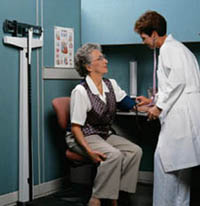High Blood Pressure / Hypertension

Blood pressure, measured with a blood pressure cuff and stethoscope by a nurse or other healthcare provider, is the force of the blood pushing against the artery walls. Each time the heart beats, it pumps blood into the arteries, resulting in the highest blood pressure as the heart contracts. One cannot take his own blood pressure unless an electronic blood pressure monitoring device is used. Electronic blood pressure monitors may also measure the heart rate, or pulse.
Two numbers are recorded when measuring blood pressure. The higher number, or systolic pressure, refers to the pressure inside the artery when the heart contracts and pumps blood through the body. The lower number, or diastolic pressure, refers to the pressure inside the artery when the heart is at rest and is filling with blood. Both the systolic and diastolic pressures are recorded as "mm Hg" (millimeters of mercury). This recording represents how high the mercury column is raised by the pressure of the blood.
High blood pressure, or hypertension, directly increases the risk of coronary heart disease (heart attack) and stroke (brain attack). With high blood pressure, the arteries may have an increased resistance against the flow of blood, causing the heart to pump harder to circulate the blood.
According to the National Heart, Lung, and Blood Institute (NHLBI) of the National Institutes of Health (NIH), high blood pressure for adults is defined as:
- 140 mm Hg or greater systolic pressure
and
- 90 mm Hg or greater diastolic pressure
In an update of NHLBI guidelines for hypertension in 2003, a new blood pressure category was added called prehypertension:
- 120 mm Hg – 139 mm Hg systolic pressure
and
- 80 mm Hg – 89 mm Hg diastolic pressure
The new NHLBI guidelines now define normal blood pressure as follows:
- Less than 120 mm Hg systolic pressure
and
- Less than 80 mm Hg diastolic pressure
These numbers should be used as a guide only. A single elevated blood pressure measurement is not necessarily an indication of a problem. Your physician will want to see multiple blood pressure measurements over several days or weeks before making a diagnosis of hypertension (high blood pressure) and initiating treatment. A person who normally runs a lower-than-usual blood pressure may be considered hypertensive with lower blood pressure measurements than 140/90.
A risk factor is anything that may increase a person's chance of developing a disease. It may be an activity such as smoking, diet, family history, or many other things. Different diseases, including cancers, have different risk factors.
Although these factors can increase a person's risk, they do not necessarily cause the disease. Some people with one or more risk factors never develop the disease, while others who do develop the disease may have no known risk factors.
But, knowing your risk factors to any disease can help to guide you into the appropriate actions, including changing behaviors and being clinically monitored for the disease.
High blood pressure can occur in anyone, but is particularly prevalent in:
- persons with diabetes mellitus, gout, or kidney disease.
- African-Americans (particularly those who live in the southeastern United States).
- persons in their early to middle adult years; men in this age group have higher blood pressure more often than women in this age group.
- persons in their middle to later adult years; women in this age group have higher blood pressure more often than men in this age group (more women have high blood pressure after menopause than men of the same age).
- middle-aged and elderly people - more than half of all Americans age 65 and older have high blood pressure.
- persons whose parents or grandparents have/had high blood pressure.
- obese people.
- heavy drinkers of alcohol.
- women who are taking oral contraceptives.
The following may contribute to an increase in blood pressure:
- being overweight
- excessive sodium intake
- a lack of exercise and physical activity
Many people can control high blood pressure by:
- choosing foods that are low in sodium (salt).
- choosing foods low in calories and fat.
- choosing foods high in starch and fiber.
- maintaining a healthy weight, or losing weight if overweight.
- limiting serving sizes.
- increasing physical activity.
- practicing moderation if consuming alcoholic beverages.
However, other people must take daily medication to control hypertension. People with hypertension should routinely have their blood pressure checked and be under the care of a physician.
Click here to view the
Online Resources of Heart Center
|